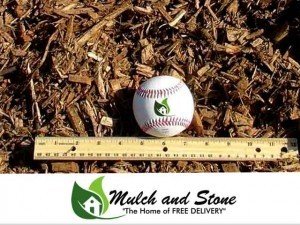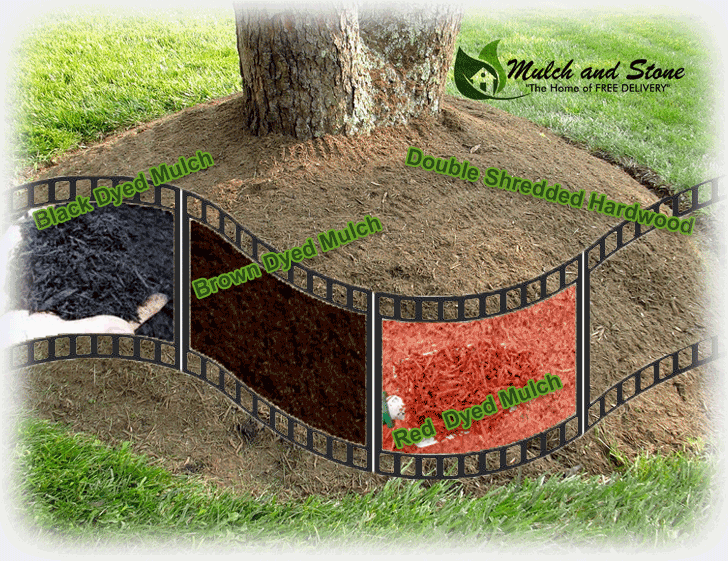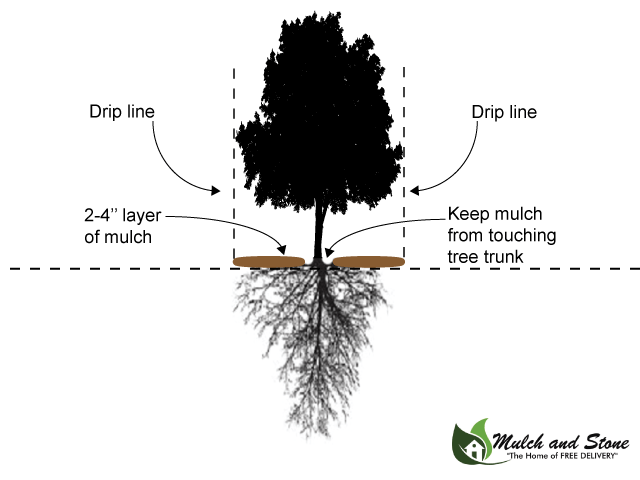
When Should I Mulch and How Much Mulch Do I Need?
Use mulch as an accent.
Mulching can help create healthy lawns but also has an aesthetic value. Choose a color that compliments the exterior colors of your home in the brick, stone, stucco and siding. For example, brown or red goes well with brick houses. Using a black mulch can contrast with flowers, improving the appearance of your landscape.
Clean out your beds before re-mulching.
Remove all weeds if re-mulching a bed and blow the beds out with a blower. This will help remove any seedlings that may have come from the trees or the yard. Then remove some of the old mulch. Sometimes mulch has been added to the beds three to four times, so we recommend taking out some that have built up over time. When you get close to an edge,
such as stepping stones, pavement, or a tree trunk; thin it out.
Try our different mulch products.
Mulch and Stone Landscape Supply has an array of options, starting with double shredded hardwood, leaf mulch, and black, brown, and red dyed mulches. These are good for conserving moisture, maintaining consistent soil temperatures, and suppressing weeds. Mulching your trees and plants keeps down weeds, thus eliminating competition for water.
Don’t ignore bare soil.
Research shows mulching has significant environmental benefits. Having bare soil on your property will cause erosion and sediment runoff. Mulching will help control erosion and runoff.
Don’t use too little or too much mulch.
It’s recommended to mulch twice a year in the spring and then again in the fall. About 3 inches of mulch is recommended. Mulching in the spring helps conserve moisture, maintain consistent soil temperatures, and suppress weeds. Mulching in the fall will help insulate your plants for wintertime. One exception is if you use gravel or a stone product, you could get away with using just 2 inches.
Don’t forget to mulch your trees.
Mulch rings are a protective area to prevent threats from other plants and keep mowers away. Add mulch to the base of your tree by removing any grass within a 3 to 10-foot area, depending on the size of your tree. There’s no benefit in having a pile of mulch next to a tree trunk. You want to taper it down, if you pile mulch against the trunk, it will hold moisture there and may lead to root rot.
Don’t assume you need to put something underneath.
Some people may want to use plastic or landscape fabric, but adding a layer of plastic or landscape fabric could cause more water runoff. If you use organic mulch that will break down, like double shredded hhardwood mulch, avoid landscape fabric because you want the mulch to be in contact with the soil to improve it. Plastic or landscape fabric could prevent water and rain from reaching the ground and increase runoff. Weeds also can grow into the landscape fabric. If the mulch shifts around or is replaced, the plastic or landscape fabric could show through.
Don’t use sour mulch.
The biggest pitfall is getting your mulch from an unreliable source, for example, landfill mulch or mulch delivered with weed seeds because it was stockpiled next to a field of weeds. We at Mulch and Stone only carry the highest quality mulches and stone products.
What are the benefits of using a mulching blade on my lawn mower?
Using a mulching blade can provide several benefits, including:
1. Improved lawn health: Mulched grass clippings enrich the soil with nutrients, promoting healthier grass growth.
2. Reduced lawn thatch: Mulching helps break down thatch by promoting microbial activity.
3. Time and effort savings: You don’t need to collect and dispose of grass clippings, saving time and effort.
4. Enhanced moisture retention: Mulch helps the soil retain moisture, reducing the need for frequent watering.





